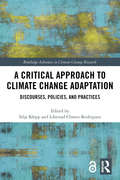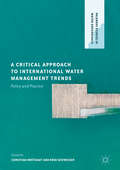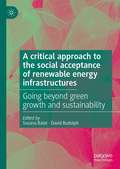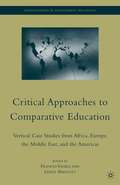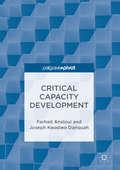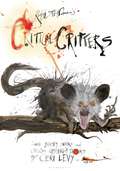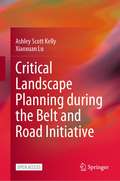- Table View
- List View
Crisis Urbanism and Postcolonial African Cities in Postmillennial Cinema (Routledge Research on Decoloniality and New Postcolonialisms)
by Addamms MututaThis book provides a framework to rethink postcoloniality and urbanism from African perspectives. Bringing together multidisciplinary perspectives on African crises through postmillennial films, the book addresses the need to situate global south cultural studies within the region. The book employs film criticism and semiotics as devices to decode contemporary cultures of African cities, with a specific focus on crisis. Drawing on a variety of contemporary theories on cities of the global south, especially Africa, the book sifts through nuances of crisis urbanism within postmillennial African films. In doing so the book offers unique perspectives that move beyond the confines of sociological or anthropological studies of cities. It argues that crisis has become a mainstay reality of African cities and thus occupies a central place in the way these cities may be theorized or imagined. The book considers crises of six African cities: nonentity in post-apartheid Johannesburg, laissez faire economies of Kinshasa, urban commons in Nairobi, hustlers in postwar Monrovia, latent revolt in Cairo, and cantonments in postwar Luanda, which offer useful insights on African cities today. The book will be of interest to students and scholars of urban studies, urban geography, urban sociology, cultural studies, and media studies.
CRISPR/Cas-Mediated Genome Editing in Plants
by Deepu Pandita Anu PanditaWith over 820 million people facing hunger in today’s world, the need of the hour is the design of plant varieties with high yield, improved traits, and resistance properties in order to mitigate the detrimental impacts of biotic and abiotic stress conditions on food crops. This volume highlights the use of Clustered Regularly Interspaced Short Palindromic Repeats (CRISPR) and CRISPR-associated nuclease proteins as a solution for sustainable agriculture. CRISPR/Cas-mediated genome editing (GE) provides a robust, simple, precise, efficient, economical, and revolutionary toolbox that leads to improved plant traits with enhanced yield, quality, and resistance against various stresses, including climate-related stress, insect pests and diseases, pollution-related stresses, etc. Key features of the book: Explains the differences between conventional breeding, genetically modified crops, and genome editing approaches using CRISPR/Cas Introduces the tools of genome editing, such as ZFNS (zinc finger nucleases), mega nucleases, and TLENS (transcription activator-like effector nucleases) Covers the history, origin, discovery, structure, and classification of CRISPR/Cas Examines the databases and computational approaches of CRISPR/Cas Highlights genome editing of important crop plants with CRISPR/Cas systems, including wheat, maize. tomato, Brassica crops, rice, fruits Explores potential applications of CRISPR/Cas systems for climate smart crops
CRISPR/Cas-Mediated Genome Editing in Plants
by Deepu Pandita Anu PanditaWith over 820 million people facing hunger in today’s world, the need of the hour is the design of plant varieties with high yield, improved traits, and resistance properties in order to mitigate the detrimental impacts of biotic and abiotic stress conditions on food crops. This volume highlights the use of Clustered Regularly Interspaced Short Palindromic Repeats (CRISPR) and CRISPR-associated nuclease proteins as a solution for sustainable agriculture. CRISPR/Cas-mediated genome editing (GE) provides a robust, simple, precise, efficient, economical, and revolutionary toolbox that leads to improved plant traits with enhanced yield, quality, and resistance against various stresses, including climate-related stress, insect pests and diseases, pollution-related stresses, etc. Key features of the book: Explains the differences between conventional breeding, genetically modified crops, and genome editing approaches using CRISPR/Cas Introduces the tools of genome editing, such as ZFNS (zinc finger nucleases), mega nucleases, and TLENS (transcription activator-like effector nucleases) Covers the history, origin, discovery, structure, and classification of CRISPR/Cas Examines the databases and computational approaches of CRISPR/Cas Highlights genome editing of important crop plants with CRISPR/Cas systems, including wheat, maize. tomato, Brassica crops, rice, fruits Explores potential applications of CRISPR/Cas systems for climate smart crops
Criteria Air Pollutants and their Impact on Environmental Health
by Pallavi Saxena Saurabh SonwaniAir pollution is a global hazard. Majority of the world’s population is affected by air pollution. Contamination of air is no more an only an atmospheric problem but now has become a health concern too. Under the Clean Air Act of 1971, a set of air pollutants are designated as criteria pollutants. These are suspected to be strongly harming the public health and the environment as compared to other primary and secondary pollutants. Globally, this category of air pollutants has been given less attention, only few studies have been reported in this area. This book begins with a short background on criteria air pollutants and their sources, sinks and chemistry. The chapters explore the detailed nature of primary pollutants criteria pollutants such as nitrogen dioxide, sulphur dioxide, carbon monoxide, particulate matter and lead. Their reaction mechanisms, climate change potency, environmental health effects on plants and human life are discussed. The book also covers secondary pollutants such as ozone. The book discusses ozone chemistry and its environmental health effects. This book act as a valuable tool for students in Environmental Science, Biological Science and Agriculture, as well as environmental consultants and professionals involved in air quality research and the application of air quality guidelines and advice.
Critical Animal Geographies: Politics, Intersections and Hierarchies in a Multispecies World (Routledge Human-Animal Studies Series)
by Kathryn Gillespie Rosemary-Claire CollardCritical Animal Geographies provides new geographical perspectives on critical animal studies, exploring the spatial, political, and ethical dimensions of animals’ lived experience and human-animal encounter. It works toward a more radical politics and theory directed at the shifting boundary between human and animal. Chapters draw together feminist, political-economic, post-humanist, anarchist, post-colonial, and critical race literatures with original case studies in order to see how efforts by some humans to control and order life – human and not – violate, constrain, and impinge upon others. Central to all chapters is a commitment to grappling with the stakes – violence, death, life, autonomy – of human-animal encounters. Equally, the work in the collection addresses head-on the dominant forces shaping and dependent on these encounters: capitalism, racism, colonialism, and so on. In doing so, the book pushes readers to confront how human-animal relations are mixed up with overlapping axes of power and exploitation, including gender, race, class, and species.
Critical Animal Geographies: Politics, Intersections and Hierarchies in a Multispecies World (Routledge Human-Animal Studies Series)
by Kathryn Gillespie Rosemary-Claire CollardCritical Animal Geographies provides new geographical perspectives on critical animal studies, exploring the spatial, political, and ethical dimensions of animals’ lived experience and human-animal encounter. It works toward a more radical politics and theory directed at the shifting boundary between human and animal. Chapters draw together feminist, political-economic, post-humanist, anarchist, post-colonial, and critical race literatures with original case studies in order to see how efforts by some humans to control and order life – human and not – violate, constrain, and impinge upon others. Central to all chapters is a commitment to grappling with the stakes – violence, death, life, autonomy – of human-animal encounters. Equally, the work in the collection addresses head-on the dominant forces shaping and dependent on these encounters: capitalism, racism, colonialism, and so on. In doing so, the book pushes readers to confront how human-animal relations are mixed up with overlapping axes of power and exploitation, including gender, race, class, and species.
A Critical Approach to Climate Change Adaptation: Discourses, Policies and Practices (Routledge Advances in Climate Change Research)
by Silja Klepp Libertad Chavez-RodriguezThis edited volume brings together critical research on climate change adaptation discourses, policies, and practices from a multi-disciplinary perspective. Drawing on examples from countries including Colombia, Mexico, Canada, Germany, Russia, Tanzania, Indonesia, and the Pacific Islands, the chapters describe how adaptation measures are interpreted, transformed, and implemented at grassroots level and how these measures are changing or interfering with power relations, legal pluralismm and local (ecological) knowledge. As a whole, the book challenges established perspectives of climate change adaptation by taking into account issues of cultural diversity, environmental justicem and human rights, as well as feminist or intersectional approaches. Chapter 3 of this book is freely available as a downloadable Open Access PDF under a Creative Commons Attribution-Non Commercial-No Derivatives 3.0 license. https://s3-us-west-2.amazonaws.com/tandfbis/rt-files/docs/Open+Access+Chapters/9781138056299_oachapter3.pdf
A Critical Approach to Climate Change Adaptation: Discourses, Policies and Practices (Routledge Advances in Climate Change Research)
by Silja Klepp Libertad Chavez-RodriguezThis edited volume brings together critical research on climate change adaptation discourses, policies, and practices from a multi-disciplinary perspective. Drawing on examples from countries including Colombia, Mexico, Canada, Germany, Russia, Tanzania, Indonesia, and the Pacific Islands, the chapters describe how adaptation measures are interpreted, transformed, and implemented at grassroots level and how these measures are changing or interfering with power relations, legal pluralismm and local (ecological) knowledge. As a whole, the book challenges established perspectives of climate change adaptation by taking into account issues of cultural diversity, environmental justicem and human rights, as well as feminist or intersectional approaches. Chapter 3 of this book is freely available as a downloadable Open Access PDF under a Creative Commons Attribution-Non Commercial-No Derivatives 3.0 license. https://s3-us-west-2.amazonaws.com/tandfbis/rt-files/docs/Open+Access+Chapters/9781138056299_oachapter3.pdf
A Critical Approach to International Water Management Trends: Policy and Practice (Palgrave Studies in Water Governance: Policy and Practice)
by Christian Bréthaut Rémi SchweizerThis edited volume provides a critical discussion of particular trends that are widely recognised to influence water management by comparing them with what is actually happening in the field. Among others, these trends include water security, adaptive or integrative management, and the water-energy-food nexus, which are often presented as essential means to reaching more sustainable and resilient water use. However, the extent to which these trends have managed to structure concrete practices in water management remains uncertain. Informed by empirically grounded research, each chapter of this work engages with a particular approach, concept or theory. Together, they provide a nuanced picture of trends in water management that require universal remedies and global norms.
A critical approach to the social acceptance of renewable energy infrastructures: Going beyond green growth and sustainability
by Susana Batel David RudolphThis book provides a critical approach to research on the social acceptance of renewable energy infrastructures and on energy transitions in general by questioning prevalent principles and proposing specific research pathways and lines of inquiry that look beyond depoliticised, business-as-usual discourses and research agendas on green growth and sustainability. It brings together authors from different socio-geographical and disciplinary backgrounds within the social sciences to reflect upon, discuss and advance what we propose to be five cornerstones of a critical approach: overcoming individualism and socio-cognitivism; repoliticisations – recognising and articulating power relations; for interdisciplinarity; interventions – praxis and political engagement with research; and overcoming localism and spatial determinism: As such, this book offers academics, students and practitioners alike a comprehensive perspective of what it means to be critical when inquiring into the social acceptance of renewable energy and associated infrastructures.
Critical Approaches to Comparative Education: Vertical Case Studies from Africa, Europe, the Middle East, and the Americas (International and Development Education)
by F. Vavrus L. BartlettThis book unites a dynamic group of scholars who examine linkages among local, national, and international levels of educational policy and practice. Utilizing multi-sited, ethnographic approaches, the essays explore vertical interactions across diverse levels of policy and practice while prompting horizontal comparisons across twelve sites in Africa, Europe, the Middle East, and the Americas. The vertical case studies focus on a range of topics, including participatory development, the politics of culture and language, neoliberal educational reforms, and education in post-conflict settings. Editors Vavrus and Bartlett contribute to comparative theory and practice by demonstrating the advantages of thinking vertically.
Critical Approaches to the Australian Blue Humanities (ISSN)
by Claire Hansen Maxine NewlandsThis interdisciplinary edited collection explores and analyses the field of the blue humanities through an Australian lens. The blue humanities is a way of understanding humanity’s relationship with water and manifestations of what is referred to as the ‘blue’ – reefs, oceans, rivers, creeks, basins, and inland bodies of water.In its scope, this collection emphasises both the importance of the local and the interconnectedness of Australia with global environmental concerns. It considers how we conceptualise watery spaces and shades of blue in a country where water is often marked by its absence, its ephemerality, its politicisation, and its dangers. Contributors from environmental history, environmental social science, political science, literary studies, creative arts, Indigenous Knowledge, education, and anthropology tackle various entanglements between the human, the more-than-human, and watery Australian spaces in modern culture. It is the first volume to offer a specific, dedicated focus on the intersections between Australian space and the blue humanities, and it offers a pathway for those wishing to explore, critique, and advance ideas around the blue humanities in both research and teaching.Directly contributing to a growing interdisciplinary field, this is the first book to comprehensively examine the blue in Australia, appealing to scholars, educators, and students working across the humanities and social sciences with an interest in the environmental humanities, ecopolitics, ecocriticism, the blue humanities, cultural geography, environmental history, and the role of place.Chapter 2 of this book is freely available as a downloadable Open Access PDF at http://www.taylorfrancis.com under a Creative Commons Attribution-Non Commercial-No Derivatives (CC-BY-NC-ND) 4.0 license.
Critical Approaches to the Australian Blue Humanities (ISSN)
by Claire Hansen Maxine NewlandsThis interdisciplinary edited collection explores and analyses the field of the blue humanities through an Australian lens. The blue humanities is a way of understanding humanity’s relationship with water and manifestations of what is referred to as the ‘blue’ – reefs, oceans, rivers, creeks, basins, and inland bodies of water.In its scope, this collection emphasises both the importance of the local and the interconnectedness of Australia with global environmental concerns. It considers how we conceptualise watery spaces and shades of blue in a country where water is often marked by its absence, its ephemerality, its politicisation, and its dangers. Contributors from environmental history, environmental social science, political science, literary studies, creative arts, Indigenous Knowledge, education, and anthropology tackle various entanglements between the human, the more-than-human, and watery Australian spaces in modern culture. It is the first volume to offer a specific, dedicated focus on the intersections between Australian space and the blue humanities, and it offers a pathway for those wishing to explore, critique, and advance ideas around the blue humanities in both research and teaching.Directly contributing to a growing interdisciplinary field, this is the first book to comprehensively examine the blue in Australia, appealing to scholars, educators, and students working across the humanities and social sciences with an interest in the environmental humanities, ecopolitics, ecocriticism, the blue humanities, cultural geography, environmental history, and the role of place.Chapter 2 of this book is freely available as a downloadable Open Access PDF at http://www.taylorfrancis.com under a Creative Commons Attribution-Non Commercial-No Derivatives (CC-BY-NC-ND) 4.0 license.
Critical Capacity Development
by Farhad Analoui Joseph Kwadwo DanquahThis book contributes to our understanding of a neglected and poorly-understood concept within the development field: ‘capacity development’ in the context of human and organisational sustainable development. Relating ‘capacity development’ to other perspectives in development thinking and practice and giving an account of the concept’s genesis, the book introduces readers to recent empirical research initiatives that help to elucidate the concepts of capacity, capacity development, and capacity management. While capacity development initiatives and programmes have been used by most international and national agencies over the course of the last five decades, the term means different things to different people and especially to different major players in the international community. This weakens its effectiveness. This book therefore strives first of all to set ground rules that can be utilised by international aid providers such as UNDP, OECD, World Bank, and CIDA and practitioners alike.
Critical Capacity Development
by Farhad Analoui Joseph Kwadwo DanquahThis book contributes to our understanding of a neglected and poorly-understood concept within the development field: ‘capacity development’ in the context of human and organisational sustainable development. Relating ‘capacity development’ to other perspectives in development thinking and practice and giving an account of the concept’s genesis, the book introduces readers to recent empirical research initiatives that help to elucidate the concepts of capacity, capacity development, and capacity management. While capacity development initiatives and programmes have been used by most international and national agencies over the course of the last five decades, the term means different things to different people and especially to different major players in the international community. This weakens its effectiveness. This book therefore strives first of all to set ground rules that can be utilised by international aid providers such as UNDP, OECD, World Bank, and CIDA and practitioners alike.
Critical Critters
by Ralph Steadman Ceri LevyFollowing on from Extinct Boids and Nextinction, Critical Critters is the third in this epic trilogy of books dedicated to extinct and critically endangered animals from cartoonist Ralph Steadman and film-maker Ceri Levy - the GONZOVATIONISTS.Expect plenty more of what made the first two books so successful - unpredictable nonsense beasts, irreverent jokes, a diary-style record of the creative mayhem, and around 100 spectacular illustrations by Ralph of critically endangered mammals, insects, fish, lizards and trees – a stunning collection, with a serious conservation message.Ceri's humorous but meaningful message accompanied by Ralph's sensational paintings will satisfy art-lovers and conservationists alike.
Critical Critters
by Ralph Steadman Ceri LevyFollowing on from Extinct Boids and Nextinction, Critical Critters is the third in this epic trilogy of books dedicated to extinct and critically endangered animals from cartoonist Ralph Steadman and film-maker Ceri Levy - the GONZOVATIONISTS.Expect plenty more of what made the first two books so successful - unpredictable nonsense beasts, irreverent jokes, a diary-style record of the creative mayhem, and around 100 spectacular illustrations by Ralph of critically endangered mammals, insects, fish, lizards and trees – a stunning collection, with a serious conservation message.Ceri's humorous but meaningful message accompanied by Ralph's sensational paintings will satisfy art-lovers and conservationists alike.
A CRITICAL EXAMINATION OF THE POSITION OF MR. DARWIN'S WORK, "ON THE ORIGIN OF SPECIES,"
by Thomas Henry HuxleyA Critical Examination of the Position of Mr. Darwin's Work, "On the Origin of Species," in Relation to the Complete Theory of the Causes of the Phenomena of Organic Nature Lecture VI. (of VI.), "Lectures to Working Men", at the Museum of Practical Geology, 1863, on Darwin's Work: "Origin of Species"
Critical Geopolitics of the Polar Regions: An Inter-American Perspective (Interamerican Research: Contact, Communication, Conflict Ser.)
by Dorothea WehrmannFocusing on both Polar Regions, this book provides a comprehensive understanding of political processes related to the rapidly changing Arctic and Antarctic, where the environmental impacts of human activities are extremely visible. Environmental changes in the Arctic and the Antarctic are increasingly seen as barometers of the global impact of human activities, while newly arising economic opportunities in both Polar Regions prompt predictions that they will be the site of future conflicts. This book maps and analyses the different actors involved in the politics of the Polar Regions to explain why similar patterns of interpretation of such major issues have become dominant in practical, popular and formal geopolitical discourses. Disentangling the politics, the author illustrates how the ordering principles have evolved, explains recent dynamics in political processes and provides the groundwork needed to better forecast future trends. By focusing on the Americas, the only continent that borders both Polar Regions, the author shows how geographic proximity inspires interaction and cooperation among state and non-state actors in very different ways. This volume will be of interest to scholars and students of political science, political geography, international relations, global governance and cultural studies. It will have an international appeal particularly in the Americas, and other countries with growing interests in the Polar Regions.
Critical Geopolitics of the Polar Regions: An Inter-American Perspective (PDF) (Interamerican Research: Contact, Communication, Conflict Ser.)
by Dorothea WehrmannFocusing on both Polar Regions, this book provides a comprehensive understanding of political processes related to the rapidly changing Arctic and Antarctic, where the environmental impacts of human activities are extremely visible. Environmental changes in the Arctic and the Antarctic are increasingly seen as barometers of the global impact of human activities, while newly arising economic opportunities in both Polar Regions prompt predictions that they will be the site of future conflicts. This book maps and analyses the different actors involved in the politics of the Polar Regions to explain why similar patterns of interpretation of such major issues have become dominant in practical, popular and formal geopolitical discourses. Disentangling the politics, the author illustrates how the ordering principles have evolved, explains recent dynamics in political processes and provides the groundwork needed to better forecast future trends. By focusing on the Americas, the only continent that borders both Polar Regions, the author shows how geographic proximity inspires interaction and cooperation among state and non-state actors in very different ways. This volume will be of interest to scholars and students of political science, political geography, international relations, global governance and cultural studies. It will have an international appeal particularly in the Americas, and other countries with growing interests in the Polar Regions.
Critical Infrastructure: Reliability and Vulnerability (Advances in Spatial Science)
by Alan T. Murray Tony GrubesicThis text brings together differing geographic perspectives in modeling and analysis in order to highlight infrastructure weaknesses or plan for their protection. Offering new methodological approaches, the book explores the potential consequences of critical infrastructure failure, stemming from both man-made and natural disasters. The approaches employed are wide-ranging, including geographic, economic and social perspectives.
Critical Infrastructures: Transportation by Road and Rail (Topics in Safety, Risk, Reliability and Quality #31)
by Bogdan I. Vamanu Adrian V. Gheorghe Polinpapilinho F. KatinaThis book addresses a key issue in today’s society: the safer transport of dangerous goods, taking into account people, the environment and economics. In particular, it offers a potential approach to identifying the issues, developing the models, providing the methods and recommending the tools to address the risks and vulnerabilities involved. We believe this can only be achieved by assessing those risks in a comprehensive, quantifiable and integrated manner. Examining both rail and road transportation, the book is divided into three sections, covering: the mature and accepted (by both academia and practitioners) methodology of risk assessment; the vulnerability assessment – a novel approach proposed as a vital complement to risk; guidance and support to build the tools that make methods and equations to yield: the Decision Support Systems. Throughout the book, the authors do not endeavor to provide THE solution. Instead, the book offers insightful food for thought for students, researchers, practitioners and policymakers alike.
Critical Infrastructures, Key Resources, Key Assets: Risk, Vulnerability, Resilience, Fragility, and Perception Governance (Topics in Safety, Risk, Reliability and Quality #34)
by Adrian V. Gheorghe Dan V. Vamanu Polinpapilinho F. Katina Roland PulferIn the face of increasing failures, comments attributed to Albert Einstein loom large: “We cannot solve our problems with the same thinking we used when we created them.” There is a pervasive feeling that any attempt to make sense of the current terrain of complex systems must involve thinking outside the box and originating unconventional approaches that integrate organizational, managerial, social, political, cultural, and human aspects and their interactions.This textbook offers research-based models and tools for diagnosing and predicting the behavior of complex techno-socio-economic systems in the domain of critical infrastructures, key resources, key assets and the open bazaar of space, undersea, and below-ground systems. These models exemplify emblematic models in physics, within which the critical infrastructures, as well as society itself and its paraphernalia, share the profile of many-body systems featuring cooperative phenomena and phase transitions – the latter usually felt as disruptive occurrences.The book and its models focus on the analytics of real-life-business actors, including policy-makers, financiers and insurers, industry managers, and emergency responders.
Critical Landscape Planning during the Belt and Road Initiative
by Ashley Scott Kelly Xiaoxuan LuThis open access book traces the development of landscapes along the 414-kilometer China–Laos Railway, one of the first infrastructure projects implemented under China’s Belt and Road Initiative (BRI) and which is due for completion at the end of 2021. Written from the perspective of landscape architecture and intended for planners and related professionals engaged in the development and conservation of these landscapes, this book provides history, planning pedagogy and interdisciplinary framing for working alongside the often-opaque planning, design and implementation processes of large-scale infrastructure. It complicates simplistic notions of development and urbanization frequently reproduced in the Laos–China frontier region. Many of the projects and sites investigated in this book are recent “firsts” in Laos: Laos’s first wildlife sanctuary for trafficked endangered species, its first botanical garden and its first planting plan for a community forest. Most often the agents and accomplices of neoliberal development, the planning and design professions, including landscape architecture, have little dialogue with either the mainstream natural sciences or critical social sciences that form the discourse of projects in Laos and comparable contexts. Covering diverse conceptions and issues of development, including cultural and scientific knowledge exchanges between Laos and China, nature tourism, connectivity and new town planning, this book also features nine planning proposals for Laos generated through this research initiative since the railway's groundbreaking in 2016. Each proposal promotes a wider "landscape approach" to development and deploys landscape architecture’s spatial and ecological acumen to synthesize critical development studies with the planner's capacity, if not naive predilection, to intervene on the ground. Ultimately, this book advocates the cautious engagement of the professionally oriented built-environment disciplines, such as regional planning, civil engineering and landscape architecture, with the landscapes of development institutions and environmental NGOs.
Critical Loads and Dynamic Risk Assessments: Nitrogen, Acidity and Metals in Terrestrial and Aquatic Ecosystems (Environmental Pollution #25)
by Wim De Vries Jean-Paul Hettelingh Maximilian PoschThis book provides a unique overview of research methods over the past 25 years assessing critical loads and temporal effects of the deposition of air pollutants. It includes critical load methods and applications addressing acidification, eutrophication and heavy metal pollution of terrestrial and aquatic ecosystems. Applications include examples for each air pollution threat, both at local and regional scale, including Europe, Asia, Canada and the US. The book starts with background information on the effects of the deposition of sulphur, nitrogen and heavy metals and geochemical and biological indicators for risk assessments. The use of those indicators is then illustrated in the assessment of critical loads and their exceedances and in the temporal assessment of air pollution risks. It also includes the most recent developments of assessing critical loads and current and future risks of soil and water chemistry and biodiversity under climate change, with a special focus on nitrogen. The book thus provides a complete overview of the knowledge that is currently used for the scientific support of policies in the field of air pollution control to protect ecosystem services.




